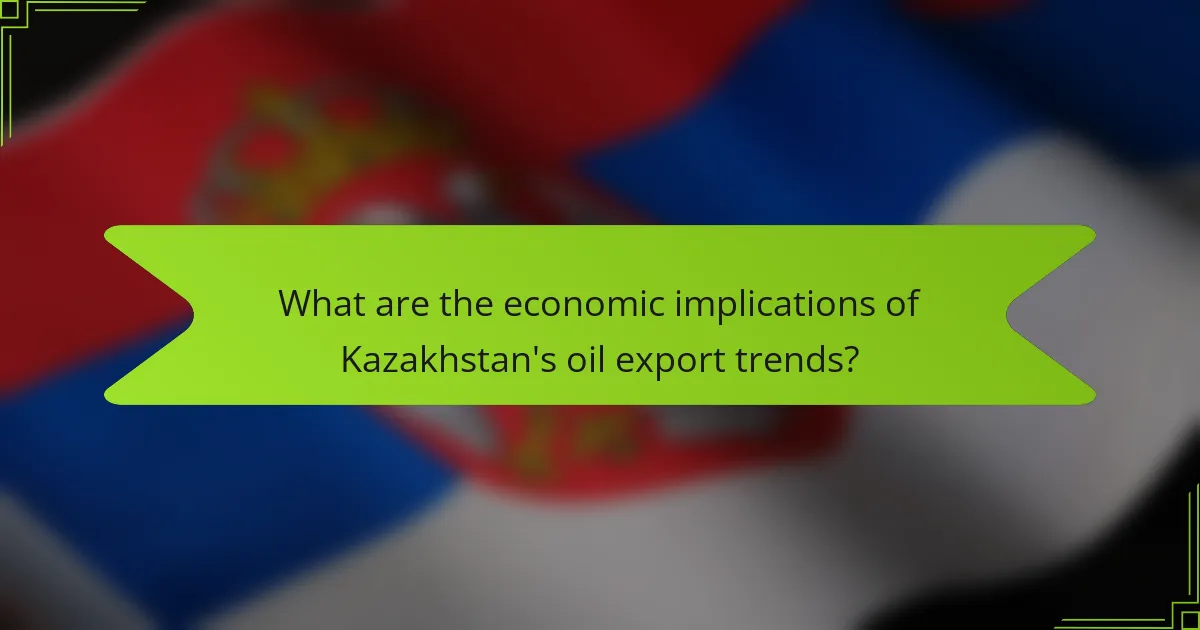Kazakhstan’s oil exports are undergoing significant changes as the country seeks to diversify its markets and reduce reliance on traditional partners like Russia. In 2023, there has been a notable increase in oil exports to China, while investments in infrastructure, such as the Trans-Caspian Pipeline, aim to connect Kazakhstan to European markets. The article explores how fluctuations in global oil prices impact Kazakhstan’s economy, which heavily depends on oil revenue, and highlights the strategic adaptations the country is making to enhance its competitiveness in the global energy landscape. Additionally, partnerships with international oil companies and the development of multiple pipeline routes are key strategies being employed to secure stable demand and increase production capacity.

What are the current trends in Kazakhstan’s oil exports?
Kazakhstan’s oil exports are currently trending towards increased diversification and expansion of markets. The country is focusing on reducing dependency on traditional markets like Russia. In 2023, Kazakhstan has seen a rise in oil exports to China, which now accounts for a significant portion of its total exports. Additionally, the government is investing in infrastructure to support new pipeline routes. This includes the Trans-Caspian Pipeline project aimed at connecting to European markets. The global demand for oil is also influencing Kazakhstan’s export strategies, as prices remain volatile. Furthermore, Kazakhstan is exploring partnerships with international oil companies to enhance production capacity. These trends indicate a strategic shift in Kazakhstan’s approach to oil exports, reflecting broader changes in the global energy landscape.
How have Kazakhstan’s oil export volumes changed over recent years?
Kazakhstan’s oil export volumes have fluctuated in recent years. In 2019, the country exported approximately 70 million tons of crude oil. This figure saw a rise in 2020, reaching around 75 million tons, largely due to increased demand from China. However, in 2021, exports decreased to about 67 million tons, impacted by global market conditions and OPEC+ production cuts. In 2022, Kazakhstan’s oil exports rebounded slightly, reaching 72 million tons, as global demand recovered. By 2023, the estimated export volume is projected to stabilize around 74 million tons. These changes reflect Kazakhstan’s adaptation to global market dynamics and its reliance on key trading partners.
What factors have influenced the fluctuations in oil export volumes?
Fluctuations in oil export volumes are influenced by multiple factors. Global demand for oil significantly impacts export levels. Economic growth in major markets like China and the U.S. drives higher demand. Conversely, economic downturns lead to decreased demand and lower export volumes.
Geopolitical events also play a crucial role. Conflicts in oil-producing regions can disrupt supply chains and affect export capabilities. Additionally, OPEC’s production decisions directly influence oil prices and export volumes. Changes in production quotas can lead to either surplus or shortage in the market.
Market prices are another critical factor. Higher prices often encourage increased production and exports. Conversely, lower prices may result in reduced output and exports.
Technological advancements in extraction and refining can enhance production efficiency. This can lead to increased export volumes as countries can produce oil more cost-effectively.
Regulatory changes, both domestically and internationally, can also impact oil exports. Stricter environmental regulations may limit production, while favorable trade agreements can boost exports.
In summary, the interplay of global demand, geopolitical events, market prices, technological advancements, and regulatory changes all contribute to fluctuations in oil export volumes.
How do seasonal variations affect oil exports from Kazakhstan?
Seasonal variations significantly impact oil exports from Kazakhstan. During winter, harsh weather conditions can disrupt transportation and logistics. This affects the ability to move oil from production sites to export terminals. In contrast, summer typically sees more stable weather, facilitating smoother operations. Increased demand for oil during colder months can also influence export volumes. For instance, higher global oil prices in winter may lead to increased exports. Historical data shows fluctuations in export levels corresponding to seasonal changes, underscoring the relationship between climate and oil trade.
What are the primary destinations for Kazakhstan’s oil exports?
Kazakhstan’s primary destinations for oil exports are Italy, the Netherlands, and China. These countries collectively receive a significant portion of Kazakhstan’s oil output. In 2022, Italy accounted for approximately 23% of Kazakhstan’s total oil exports. The Netherlands followed closely, receiving about 20% of the exports. China is also a key destination, importing around 15% of Kazakhstan’s oil. These countries play a crucial role in the global oil market, influencing Kazakhstan’s export strategies.
Which countries are the largest importers of Kazakhstan’s oil?
The largest importers of Kazakhstan’s oil are Italy, the Netherlands, and China. In 2021, Italy imported approximately 14 million tons of oil from Kazakhstan. The Netherlands followed closely, importing around 10 million tons. China is also a significant importer, with approximately 8 million tons in the same year. These countries are vital to Kazakhstan’s oil export strategy. They contribute significantly to Kazakhstan’s economy through oil revenues.
How do geopolitical relationships impact export destinations?
Geopolitical relationships significantly influence export destinations. These relationships determine trade agreements and tariffs. Favorable relations can lead to reduced barriers and increased trade volume. For example, Kazakhstan’s ties with China enhance its oil export capacity. Conversely, strained relations with Western nations can limit market access. Historical events, such as sanctions, illustrate this impact. In 2014, sanctions against Russia affected its oil exports, redirecting flows to Asia. Thus, geopolitical dynamics shape the landscape of global oil trade.
What is the role of Kazakhstan’s oil in the global market?
Kazakhstan’s oil plays a significant role in the global market as a major exporter. The country is ranked among the top ten oil producers in the world. In 2022, Kazakhstan produced approximately 1.5 million barrels per day. This production contributes to global oil supply stability. Kazakhstan’s oil is primarily exported to Europe and Asia. The Caspian Pipeline Consortium facilitates these exports. Additionally, Kazakhstan’s oil reserves are estimated at around 30 billion barrels. This positions the country as a key player in energy security discussions. The global demand for oil further enhances Kazakhstan’s strategic importance.
How does Kazakhstan’s oil production compare to other major oil-producing countries?
Kazakhstan’s oil production ranks among the top 15 oil-producing countries globally. In 2022, Kazakhstan produced approximately 1.8 million barrels per day. This output is significantly lower than leaders like the United States and Saudi Arabia, which produce over 11 million barrels per day. However, Kazakhstan’s production is comparable to countries like Azerbaijan and Nigeria. Kazakhstan’s oil reserves are substantial, estimated at around 30 billion barrels. The country primarily exports crude oil to Europe and Asia, influencing global oil markets. Its production levels contribute to the overall dynamics of OPEC+ agreements.
What influence does Kazakhstan’s oil have on global oil prices?
Kazakhstan’s oil significantly influences global oil prices. The country is one of the top oil producers in the world. In 2021, Kazakhstan produced approximately 1.8 million barrels per day. Its production levels affect supply dynamics in international markets. When Kazakhstan increases production, it can lead to lower global prices. Conversely, production cuts can tighten supply and raise prices. Kazakhstan is a member of OPEC+, which coordinates output levels with other oil-producing nations. This collaboration can amplify its impact on global oil prices. Overall, Kazakhstan’s oil production decisions are closely monitored by market analysts and traders.

What are the economic implications of Kazakhstan’s oil export trends?
Kazakhstan’s oil export trends significantly impact its economy. The country relies heavily on oil exports for revenue. In 2022, oil exports accounted for approximately 60% of Kazakhstan’s total export earnings. Fluctuations in global oil prices directly affect national income. For example, a drop in oil prices can lead to budget deficits. Conversely, rising prices enhance economic stability and growth prospects. Additionally, oil export trends influence foreign investment in Kazakhstan’s energy sector. Increased investment can lead to job creation and technological advancements. Overall, Kazakhstan’s economic health is closely tied to its oil export performance.
How do oil exports contribute to Kazakhstan’s GDP?
Oil exports significantly contribute to Kazakhstan’s GDP. In 2021, oil accounted for approximately 25% of the country’s GDP. The oil sector is a major source of revenue for the government. It generates substantial foreign exchange earnings. This revenue is crucial for funding public services and infrastructure projects. Kazakhstan is one of the largest oil producers in the region. The country exports oil primarily to Europe and Asia. Fluctuations in global oil prices directly impact GDP growth. Higher oil prices lead to increased export revenues, boosting economic performance.
What percentage of Kazakhstan’s GDP is derived from oil exports?
Approximately 20% of Kazakhstan’s GDP is derived from oil exports. This significant percentage highlights the country’s reliance on oil as a major economic driver. Oil exports contribute substantially to government revenue and foreign currency earnings. Kazakhstan is one of the largest oil producers in the region. The energy sector plays a crucial role in the overall economic landscape. Fluctuations in global oil prices can directly impact Kazakhstan’s economic stability. Data from the World Bank and Kazakhstan’s Ministry of Energy supports these figures.
How do oil revenues affect public spending in Kazakhstan?
Oil revenues significantly influence public spending in Kazakhstan. The country relies heavily on oil exports, which contribute a substantial portion of its GDP. In 2021, oil revenues accounted for approximately 30% of Kazakhstan’s total government revenue. This income allows the government to allocate funds for infrastructure projects, social programs, and public services.
In times of high oil prices, public spending often increases, leading to economic growth. Conversely, when oil prices drop, the government may face budget deficits, resulting in reduced spending. For instance, during the 2014 oil price decline, Kazakhstan experienced cuts in public expenditure.
Overall, the correlation between oil revenues and public spending is direct and significant, shaping the country’s economic landscape.
What challenges does Kazakhstan face in its oil export sector?
Kazakhstan faces several challenges in its oil export sector. Infrastructure limitations hinder efficient transportation of oil to global markets. The Caspian Sea’s geopolitical complexities complicate export routes. Environmental concerns also pose regulatory challenges for oil production. Moreover, reliance on a few key export markets increases vulnerability to price fluctuations. Domestic political stability affects investment in the oil sector. Additionally, competition from other oil-producing countries impacts Kazakhstan’s market share. These factors collectively threaten the sustainability and growth of Kazakhstan’s oil exports.
How do infrastructure limitations impact oil exports?
Infrastructure limitations significantly hinder oil exports by restricting transportation and processing capacity. Insufficient pipelines can lead to bottlenecks, preventing timely delivery of oil to markets. Limited storage facilities may cause operational delays during peak production periods. In Kazakhstan, outdated infrastructure has historically constrained export volumes. For instance, the Caspian Pipeline Consortium’s capacity issues have affected export reliability. Furthermore, inadequate rail and port facilities can increase shipping costs and reduce competitiveness. These factors collectively diminish the ability to respond to global market demands effectively.
What environmental concerns are associated with oil extraction and export?
Oil extraction and export pose several environmental concerns. These include habitat destruction, water pollution, and greenhouse gas emissions. Habitat destruction occurs due to land clearing and drilling activities. Water pollution can result from oil spills and runoff, contaminating local water sources. Greenhouse gas emissions contribute to climate change, exacerbating global warming. According to the International Energy Agency, oil extraction and refining processes release significant amounts of carbon dioxide. Additionally, the World Wildlife Fund highlights that oil spills can devastate marine ecosystems. These factors collectively illustrate the environmental risks associated with oil extraction and export.

How does Kazakhstan’s oil export strategy adapt to global market changes?
Kazakhstan’s oil export strategy adapts to global market changes by diversifying its export routes and partners. The country has developed multiple pipelines, such as the Caspian Pipeline Consortium, to reach various markets. This diversification helps mitigate risks associated with reliance on a single market. Additionally, Kazakhstan adjusts its pricing strategies based on global oil prices. For instance, during price fluctuations, it may offer discounts to attract buyers. The government also invests in refining capacity to increase value-added exports. Moreover, Kazakhstan engages in bilateral agreements with countries like China and Russia to secure stable demand. These adaptations enhance Kazakhstan’s competitiveness in the global oil market.
What strategies is Kazakhstan implementing to enhance its oil export capabilities?
Kazakhstan is implementing several strategies to enhance its oil export capabilities. The country is investing in infrastructure improvements, such as expanding pipeline capacity. This includes the modernization of the Caspian Pipeline Consortium, which transports oil to the Black Sea. Additionally, Kazakhstan is diversifying its export routes to reduce dependency on any single market. This involves exploring new partnerships with neighboring countries and enhancing rail and shipping options. Furthermore, Kazakhstan is focusing on attracting foreign investment to boost production efficiency. The government is also implementing policies to streamline regulatory processes for oil companies. These strategies aim to increase overall export volumes and stabilize revenue from oil sales.
How is Kazakhstan diversifying its export routes?
Kazakhstan is diversifying its export routes by developing new transportation corridors. This includes enhancing rail links to China and Europe. The country is also investing in pipeline infrastructure. Notable projects include the Caspian Pipeline Consortium and the Trans-Caspian International Transport Route. These initiatives aim to reduce reliance on traditional routes. Additionally, Kazakhstan seeks to strengthen maritime transport through the Caspian Sea. The government is promoting partnerships with neighboring countries for better connectivity. This strategy is expected to increase export capacity and market access.
What technological advancements are being adopted in the oil sector?
The oil sector is adopting several technological advancements. These include digital oilfield technologies, which enhance operational efficiency. Advanced data analytics are used for predictive maintenance and decision-making. Automation and robotics are improving drilling and production processes. Enhanced oil recovery techniques are increasing extraction rates from existing fields. Blockchain technology is being implemented for supply chain transparency. Artificial intelligence is optimizing exploration and production activities. These advancements lead to cost reduction and increased production efficiency in the oil industry.
How can Kazakhstan respond to fluctuations in global oil demand?
Kazakhstan can respond to fluctuations in global oil demand by diversifying its economy and enhancing oil production efficiency. Diversification reduces dependency on oil revenues. This strategy includes investing in renewable energy sources and other sectors like agriculture and technology. Enhancing production efficiency involves adopting advanced extraction technologies. For instance, Kazakhstan has invested in enhanced oil recovery techniques. These methods can increase output even during low demand periods. Additionally, Kazakhstan can establish strategic oil reserves to buffer against price volatility. Historical data shows that countries with reserves can stabilize their economies during demand drops. By implementing these strategies, Kazakhstan can better navigate the challenges of global oil market fluctuations.
What measures can Kazakhstan take to stabilize its oil revenues?
Kazakhstan can stabilize its oil revenues by diversifying its economy. This reduces reliance on oil and mitigates risks from price volatility. Investment in renewable energy can create alternative revenue streams. Strengthening fiscal policies can enhance budget stability during price fluctuations. Establishing a sovereign wealth fund can help manage surplus revenues. Implementing strategic partnerships with global oil companies can improve technology and efficiency. Enhancing infrastructure for transportation and refining can increase market access. These measures align with global trends and can support long-term economic resilience.
How does Kazakhstan plan to maintain competitiveness in the global market?
Kazakhstan plans to maintain competitiveness in the global market by diversifying its economy and enhancing its oil export strategies. The country aims to reduce reliance on oil by investing in sectors like agriculture, manufacturing, and technology. Kazakhstan is also focusing on improving infrastructure to facilitate trade and attract foreign investment. Additionally, the government is implementing policies to enhance the business environment and regulatory framework. These initiatives are supported by significant investments in energy efficiency and renewable energy sources. According to the World Bank, these strategies are essential for sustainable economic growth and resilience against global market fluctuations.
What best practices can Kazakhstan adopt for sustainable oil export growth?
Kazakhstan can adopt several best practices for sustainable oil export growth. First, it should enhance its regulatory framework to ensure environmental protection. This includes implementing stricter environmental standards for oil extraction and transportation. Second, Kazakhstan can invest in renewable energy technologies. Diversifying energy sources will reduce dependency on oil exports. Third, improving infrastructure is crucial. Upgrading pipelines and transportation networks can increase efficiency and reduce costs. Fourth, Kazakhstan should focus on international partnerships. Collaborating with global oil companies can bring in expertise and investment. Fifth, adopting advanced technologies in oil extraction can enhance recovery rates. Utilizing methods like enhanced oil recovery can maximize output. Lastly, Kazakhstan should prioritize transparency in its oil sector. Clear reporting and governance can build investor confidence. These practices can help Kazakhstan achieve sustainable growth in its oil exports.
Kazakhstan’s oil export trends are characterized by diversification of markets and infrastructure development aimed at reducing dependency on traditional partners like Russia. The article analyzes recent fluctuations in export volumes, influenced by global demand, geopolitical factors, and seasonal variations, highlighting key destinations such as China, Italy, and the Netherlands. It also discusses the economic implications of oil exports on Kazakhstan’s GDP and public spending, as well as challenges faced in the sector, including infrastructure limitations and environmental concerns. Furthermore, the article outlines strategies for enhancing export capabilities and maintaining competitiveness in the global oil market.